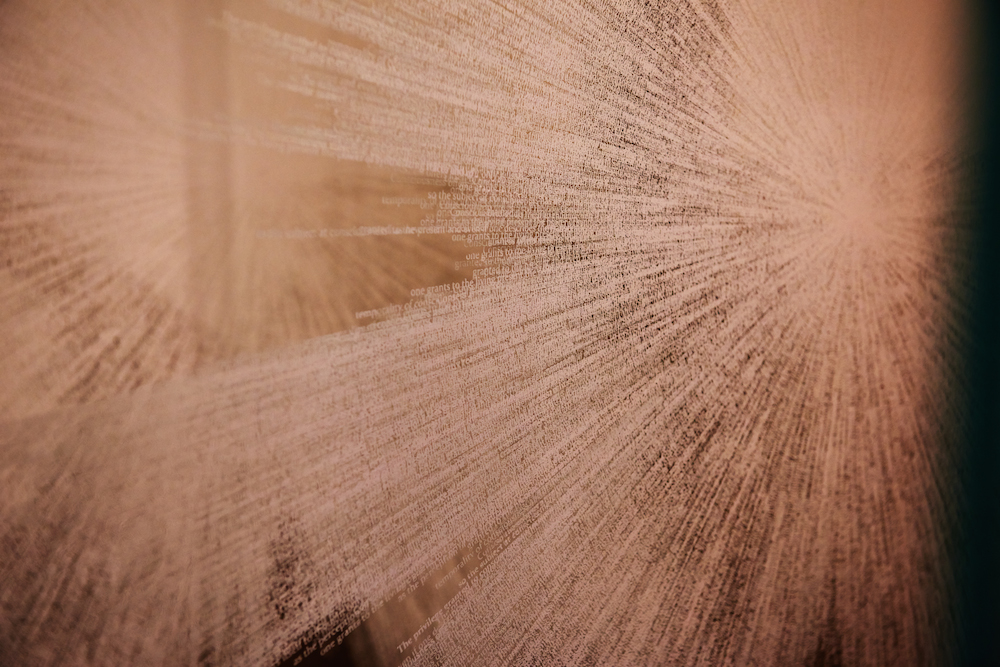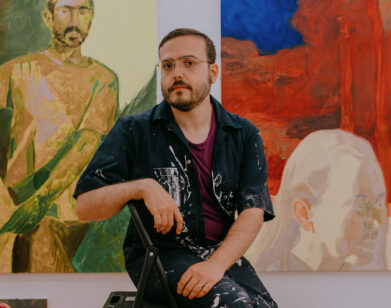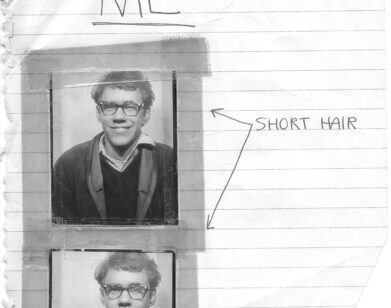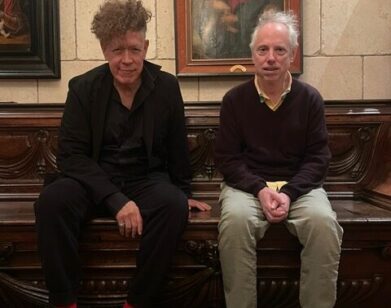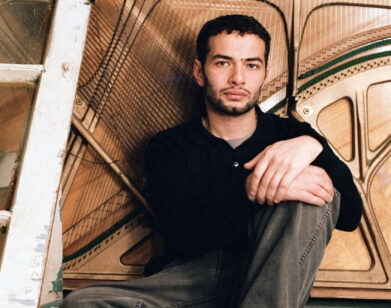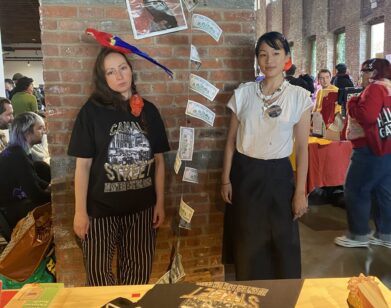Into the Abyss with Idris Khan
IDRIS KHAN IN NEW YORK, SEPTEMBER 2015. PHOTOS: HANS NEUMANN.
Growing up with a Pakistani father, London-based artist Idris Khan learned and practiced the rituals of Islam throughout childhood. He repeated specific words on a weekly basis, prayed five times a day, and now, whether he consciously realizes it or not, these melodic patterns work their way into his artwork. Khan’s current exhibit at Sean Kelly Gallery in New York (his first in the city since 2010) is appropriately titled “Overture,” as it provides an overview of Khan’s meditative practice, which includes rhythmic composite photographs, oil stick paintings, drawings, and most recently, glass sculpture. Each work—be it a starburst of words and sentences repeatedly stamped onto a canvas to the point of illegibility, or a photographic composite of 2,000 images—begs the viewer to question the artist’s original intent, while simultaneously projecting an individual interpretation.
“I write a bunch of sentences, almost like a collection of words rather than something that makes sense,” Khan explains of his process. “When you read them back, they don’t make sense. It’s quite a secretive way of working; no one actually knows what’s being said. You really have to investigate.”
Khan, who received his master’s degree from the Royal College of Art in London, often channels the movement seen in photographs made by Eadweard Muybrige to create his own compelling, yet minimal imagery. In “Overture,” visitors are greeted by Khan’s fourth-ever site-specific wall drawing, but it is his first to blend Arabic numerals with English syntax. Overture, a large glass sculpture, appears like one of his stamped paintings stretched out over seven panels. When each panel is viewed separately, words can be discerned, but when seen from the front, the seven panels and bursts of white words blend into one cloud-like abyss. In the basement of the gallery, a photograph Khan originally made for The New York Times Magazine hangs adjacent to the first oil stick painting he has ever exhibited (he typically photographs each step of the painting process and uses thousands of images to create one final composite photograph). Despite the works’ relative abstractions, Khan, with this show, aims to address the displacement of millions of people and ongoing conflicts around the world.
Just before the opening of “Overture,” we met the artist at the gallery, where we spoke while walking through the expansive three-room exhibition.
EMILY MCDERMOTT: This is the first time you worked with glass. What was that like?
IDRIS KHAN: It was difficult. [laughs] The main reason, in some way, was to do with manufacturing. Normal glass, you ask for a piece that goes into a frame, into a window. This was trying to find a perfect sheet of glass and they can’t really get their heads around the fact that you want it to be completely visible, and everything has to be perfect with no marks at all. Using glass, it’s a nice material because we’re so used to looking through glass, and now we’re looking at it, or at its surface. We’re more aware of it. A friend of mine called this piece “The Cloud of Unknowing.” With the different shapes [on the glass panels], I had to find a way of becoming dynamic and keep some sort of openness through each piece.
MCDERMOTT: You’ve drawn from various texts and references for all of your works—everything from classical musical compositions to the Qur’an. What was the starting point for this show?
KHAN: The sculpture was inspired by Jacques Derrida and his essays and theories on deconstruction. I started reading about that and had the idea of deconstructing one of my paintings, essentially, or taking one off the wall and opening it up—what that’d look like and how to experience it. It would be like you were opening time up in a way.
Then with what’s going on in the world, I started creating a lot of images of conflict, the displacement of people, and how that affects me emotionally. I started to write and read about that topic, this idea of deconstruction, displacement, those thoughts, feelings, and also other people’s notions of coming out of something like that. I knew I wanted them to be white.
When I first made these pieces about five years ago I was going through a difficult time; I lost my mother, and my wife and I lost a baby really late into the pregnancy, both in one four-month period. So I wanted make a piece of work where I was stamping away grief and emotions. I came into the studio and I’d make these little stamps of words or whatever I was thinking, and I’d stamp away all these thoughts. It became a cathartic way of understanding my emotions. They developed into these larger paintings and brought in all of these different thoughts. In a way, the reason why I called the show “Overture” is just a way of encapsulating all my work and bringing it together in one show.
MCDERMOTT: The white kind of becomes a rebirth motif—you wanting it to be white, while simultaneously releasing these darker emotions.
KHAN: Yeah, that’s a nice way of thinking about it. I’m not a political artist in any way, but if an idea takes me somewhere or something is emotionally impactful, I find a way to make a painting that encapsulates it. That’s why I wanted to keep this show white and fresh: You’re drawn to the painting, but you still feel lost. The fact that it’s white on white, I don’t think you fully know where you are when you’re looking at it. That’s the beauty of the abstraction of the words; they become meaningless, but really powerful. The fact that you can only see fragments at the end of the sentence or the start of the sentence, the viewer can put whatever they want into it.
MCDERMOTT: Even the lack of color allows for a lot of that. The wall drawing is black, though. Why did you do that?
KHAN: I knew it was going to be at the start of the show. When you walk into the gallery, you get this impact of black and then you have this much more serene quality. I’ve made four wall drawings, and they’re all slightly different. I wanted this one to have a kind of musical element to it, [with] real thin pencil lines in the background. [pauses] I don’t know if you’re aware of Roland Barthes’s “punctum,” the idea of something that jumps out and holds you while you look, but I started writing about these pictures that were coming out of different media and trying to grasp onto something. I would just keep writing and writing, photographing each stage of the painting.
MCDERMOTT: So you write and then photograph the writing?
KHAN: Correct. This is an image made up of around 1,800 photographs digitally composed, layered. You can see the traces.
MCDERMOTT: Yeah, you expect there to be a texture when you walk close to the image.
KHAN: Exactly. That’s the kind of perception I’ve always had within my photographic work. My work since 2004 has been about that question of, “What am I looking at?” Now, at this exhibition, you sense of all of that. The people are looking around and thinking about where they are, and how they’re deceived.
MCDERMOTT: Can you tell me about Go Back to Move Forward, the nine stamped pieces of sheet music?
KHAN: This is actually the last piece I made for the show. I looked through my drawers in the studio and found things that I was stamping on when I first made stamp pictures—it was all music paper. I wanted a series of works on paper in this show, but I was using this green printer paper and thought, “Nothing is working, I don’t really like it.” Then I came across the sheet music. What I liked when I was playing around with it was the fact that by blanking out the music and stamping on top of it, I was almost creating a rhythm that allowed the music to jump across the page. For me, it doesn’t matter what the music is. It’s just a way of creating a composition.
MCDERMOTT: You’ve been working with stamping for a longtime, but how did you first become interested in it?
KHAN: I was doing a lot of overlaid things with sculpture where I blasted steel and then sandblasted letters and words onto the steel. Then I wanted to find a toy-like element to the work, or make drawings. I thought, “How can I create a spiral effect or drawing effect with words?” [Stamping] was the closest thing I could do without using my hands. Written word in pencil didn’t make much sense, whereas stamping was something quite emotional and rhythmical. It became like music, or like chanting.
MCDERMOTT: Do you play music?
KHAN: My mother loved piano, she always had music in the house when I was growing up, but I don’t play an instrument… In a way it’s not so much a reference to music as it’s a reference to rhythm. My father is from Pakistan so we were taught Islam. I started practicing when I was 15. There’s so much rhythm in that religion: You have to pray five times a day, and are always repeating words. Maybe that’s inherent in what I do in the studio.
MCDERMOTT: Some of the images are so chaotic, yet they have this meditative quality as well.
KHAN: Yes, they somehow feel more calm and serene. What’s great about this gallery is that it’s got three rooms, so you can play with what you want everyone to take away. You start thinking differently about each room. In the show, you’re left with this picture [Why Do They Go, 2015], which I made for The New York Times Magazine. Two years ago, Kathy Ryan called me and said, “Can you make an image about why British Muslims fight in Syria, or why do they go?” I wanted to make sure I knew what was being said [in the article], what the stories were, before I made something like this because it could be propaganda or something you don’t want your name associated with. I wanted to make an image that was powerful, but sympathetic. The reason why I kept this image in the show is that you come downstairs, you look at this, and then suddenly you think differently about upstairs.
MCDERMOTT: It takes the abstraction and makes the deeper meanings more concrete. Also, to a certain degree, the blurred movement reflects Eadweard Muybridge, and I know you did a whole series after him. Are you still influenced by him?
KHAN: The “Rising” series, I made that in 2005. Muybridge’s imagery and the way movement and time is encapsulated, I know, it’s everywhere isn’t it? You have this great rhythm to a picture.
MCDERMOTT: Language is obviously also very important to your works. Do you have books that you find yourself consistently returning to?
KHAN: Agnes Martin, Writings, I love returning to that. She’s massively inspiring to me as an artist. [I first encountered her work] the first time I came to New York. When I finished at the Royal College, Charles Saatchi bought some of my work, so I had a bit of money and thought, “I’ve got to go to New York.” I saw Agnes Martin’s works, a series of works at the MoMA. I needed to know more about her. I was blown away by the consistency and determination to always stick to something. Her magical one idea could shift slightly and it would still be magical. I was reading more and more about her and seeing more of her works. I liked the link between artist and writing, how inspiring that can be. I came to her quite late in my artist education.
MCDERMOTT: If you came to her so late in your education, what originally inspired you to start making art while growing up?
KHAN: Abstract Impressionism, the big American painters—the Pollocks, de Koonings. I trained as a photographer, even though I was always more interested in the painting. I was never interested in documentary photographers, but of course I studied them. In ’90s when I was studying, there was a lot of British realism within the photographic schools, really in your face documentary—Martin Parr, Boris Mikhailov, people like that—coming out of Europe, showing Russia the way it was with really haunting imagery. I went the other way; I always wanted to make an abstract photograph. I would photograph walls, sports interiors, marks on the walls people made. Even looking back it makes so much sense. It’s like it was a fight against the photograph.
“OVERTURE” WILL BE ON VIEW AT SEAN KELLY GALLERY THROUGH OCTOBER 24.

